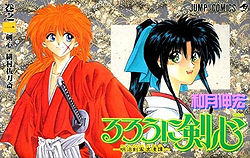
List of Rurouni Kenshin chapters
Encyclopedia

Rurouni Kenshin
, also known as Rurouni Kenshin and Samurai X, is a Japanese manga series written and illustrated by Nobuhiro Watsuki. The fictional setting takes place during the early Meiji period in Japan. The story is about a fictional assassin named Himura Kenshin, from the Bakumatsu who becomes a wanderer to...
were written and illustrated by Nobuhiro Watsuki
Nobuhiro Watsuki
is a Japanese manga artist, best known for his samurai-themed series Rurouni Kenshin. He once worked as an assistant for his favorite author Takeshi Obata.-Biography:...
. The first chapter of Rurouni Kenshin premiered in Shueisha
Shueisha
is a major publisher in Japan. The company was founded in 1925 as the entertainment-related publishing division of Japanese publisher Shogakukan. The following year, Shueisha became a separate, independent company. Magazines published by Shueisha include Weekly Shōnen Jump, Weekly Young Jump,...
's Weekly Shōnen Jump
Weekly Shonen Jump
is a weekly shōnen manga anthology published in Japan by Shueisha under the Jump line of magazines. The first issue was released with a cover date of July 2, 1968, and it is still circulating. One of the longest-running manga magazines in Japan, it has a circulation of 2.8 million copies...
in 1994 and the series ran in the magazine until 1999. The story takes place during the early Meiji period
Meiji period
The , also known as the Meiji era, is a Japanese era which extended from September 1868 through July 1912. This period represents the first half of the Empire of Japan.- Meiji Restoration and the emperor :...
in Japan and follows a fictional assassin named Himura Kenshin
Himura Kenshin
, known as Kenshin Himura in the English-language anime dubs, is a fictional character from the Rurouni Kenshin universe created by Nobuhiro Watsuki. He is the main protagonist of the manga and anime series, as well as the related media in the franchise...
, formerly known as the ,"Hitokiri" means "manslayer", however, "Battōsai" does not have a literal meaning. While "battō" is a reference to battōjutsu
Battojutsu
is a Japanese term meaning techniques for engaging a sword. It is often used interchangeably with the terms iaijutsu, battōdō, or iaidō, although each term does have nuances in the Japanese language and different schools of Japanese martial arts may use them to differentiate between techniques...
, "sai" means "purify". who becomes a wanderer to protect the people from Japan.
The 255 individual chapters known as "Acts", as well as a few one-shots authored by Watsuki were collected and published in 28 tankōbon
Tankobon
, with a literal meaning close to "independently appearing book", is the Japanese term for a book that is complete in itself and is not part of a series , though the manga industry uses it for volumes which may be in a series...
volumes by Shueisha. The first volume was released on September 2, 1994 and the last on November 4, 1999. In July 2006, Shueisha re-released the series in a twenty-two kanzenban special edition volumes. A single chapter follow up to the series, , was originally published in Weekly Shōnen Jump after the conclusion of the series. The chapter is focused on Myōjin Yahiko
Myojin Yahiko
, known as Yahiko Myojin in the Media Blasters English-language dub and Yoshi Myojin in the English Sony Samurai X dub, is a fictional character from the Rurouni Kenshin manga and anime series authored by Nobuhiro Watsuki...
some time after the end of the series when he is requested to take care of a dojo for a short time. Left out of the original volumes, the chapter added as an extra to the final kanzenban release.
The first eighteen volumes were adapted into an anime
Anime
is the Japanese abbreviated pronunciation of "animation". The definition sometimes changes depending on the context. In English-speaking countries, the term most commonly refers to Japanese animated cartoons....
produced by Studio Deen
Studio DEEN
is a Japanese company that produces anime. Three years after Sunrise was founded in 1972, Studio Deen was established by Sunrise's members in 1975. As a result of this, anime shows such as Cowboy Bebop that were produced by Sunrise may have had assistance from Studio Deen.-Produced anime:* Urusei...
, and aired in Japan from January 10, 1996 to September 8, 1998. Additionally, several parts of the following volumes were adapted into two original video animation
Original video animation
, abbreviated as media , are animated films and series made specially for release in home-video formats. The term originated in relation to Japanese animation...
s series.
Rurouni Kenshin was licensed for an English-language release in North America by Viz Media
VIZ Media
VIZ Media, LLC, headquartered in San Francisco, is an anime, manga, and Japanese entertainment company. It was founded in 1986 as VIZ LLC. In 2005, VIZ LLC and ShoPro Entertainment merged to form the current VIZ Media LLC, which is jointly owned by Japanese publishers Shogakukan and Shueisha, and...
. The first volume of the series was released on October 7, 2003. The first volumes were published on an irregular, but a monthly basis was established by Viz media after volume seven due to good sales and consumer demands. The last volume was published on July 5, 2006. Yahiko no Sakabatō was also serialized in Shonen Jump
Shonen Jump (magazine)
Shonen Jump, officially stylized SHONEN JUMP and abbreviated SJ, is a shōnen manga anthology published in North America by Viz Media. It debuted in November 2002 with the first issue having a January 2003 cover date...
during 2006. In January 2008, Viz re-released the manga in a wide-ban format called "VIZBIG Edition", which is a collection of three volumes in one.

